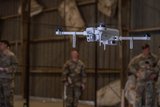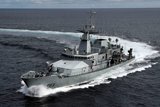US ends support for Japan crashed fighter jet search
The US Navy has ended operations assisting Japan's search for a stealth fighter jet that crashed in the Pacific, after some of its debris was recovered.
‘A US Navy salvage team aboard a contracted vessel completed its mission supporting search and recovery operations with the Japan Self-Defense Forces,’ the US 7th Fleet said in a statement on 8 May.
Japan will continue searching for the remains of the plane, a defence spokesman said.
Some debris has already been recovered from the high-tech F-35A that plummeted into the sea off the coast of north-eastern Japan on 9 April. But the ‘all-important’ memory that could offer clues into the accident has not been recovered, and the jet's pilot has also not been found.
Experts say Japan and the US are keen to prevent debris from the plane being recovered by Russia or China, with Japan's Defence Minister Takeshi Iwaya admitting last month there were ‘a significant amount of secrets that need to be protected’ on board.
The fighter jet went missing on 9 April while flying 135km east of Misawa, north-eastern Japan, on a training mission. The plane lost contact about 30mins after taking off from Misawa Air Base with three other aircraft.
It was the first reported case of a crash by an F35-A, according to Japan's Air Self-Defence Force.
Japan is deploying F35-As, each of which costs more than ¥10 billion yen ($90 million), to replace its ageing F-4 fighters. They are a key part of Prime Minister Shinzo Abe's efforts to upgrade the nation's military capacity to meet changing power dynamics in East Asia, with China rapidly modernising its military.
More from Defence Notes
-
![What will next-gen counter-UAS capabilities for the US look like?]()
What will next-gen counter-UAS capabilities for the US look like?
Future US counter-uncrewed aerial system solutions are likely to require a flexible, multi-layered approach to tackle a broad spectrum of new threats as they emerge.
-
![Elbit Systems awarded $2.3 billion contract as results soar]()
Elbit Systems awarded $2.3 billion contract as results soar
The company’s order backlog as of 30 September totalled $25.2 billion and more than a third of this is scheduled to be fulfilled before the end of 2026.
-
![US military foresees growing use of 3D printing]()
US military foresees growing use of 3D printing
Advanced manufacturing has evolved to meet military requirements and now supports multiple US critical assets, including Arleigh Burke-class destroyers, F-18, F-22, F-35, Bradley, HMMWV and Patriot.
-
![Irish Naval Service expands as the country looks to defence during EU presidency]()
Irish Naval Service expands as the country looks to defence during EU presidency
The Irish Naval Service has struggled to maintain capability, particularly in the face of lucrative private sector offers luring away personnel.
























